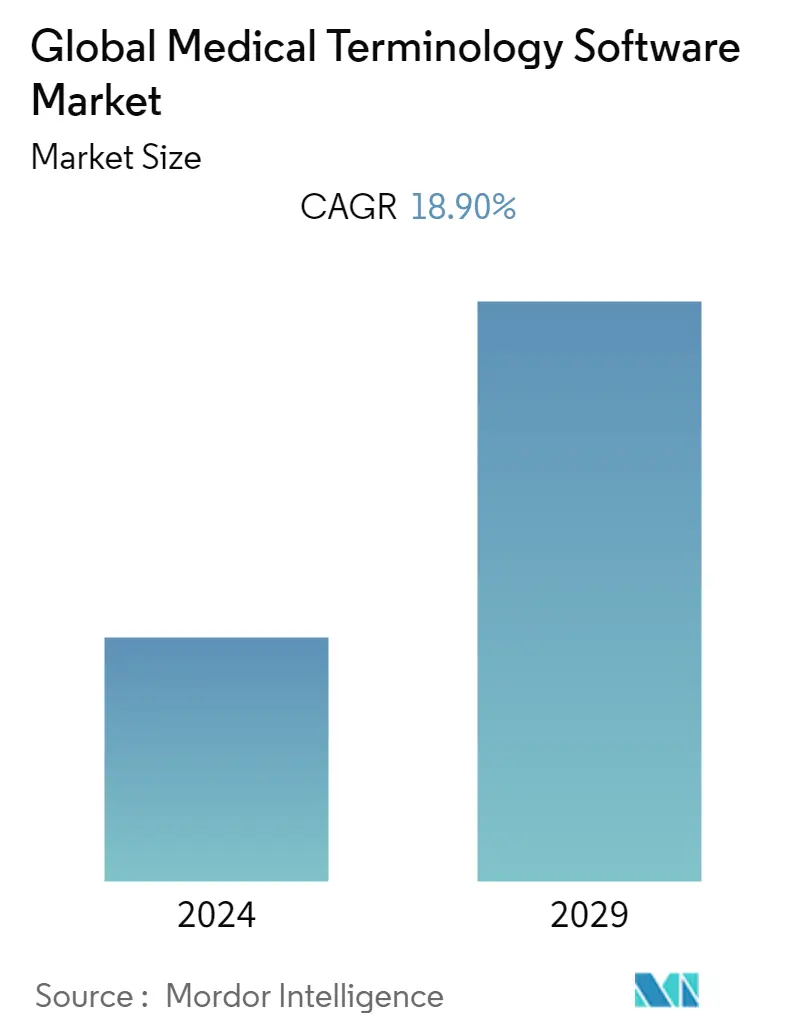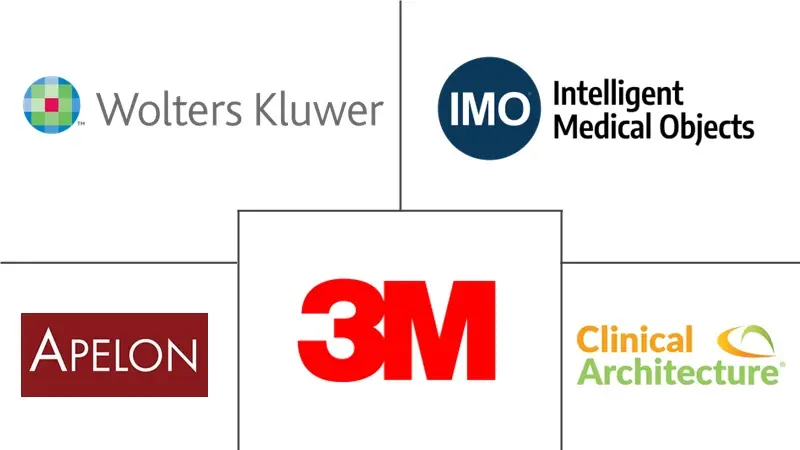Market Size of Global Medical Terminology Software Industry

| Study Period | 2019 - 2029 |
| Base Year For Estimation | 2023 |
| CAGR | 18.90 % |
| Fastest Growing Market | Asia-Pacific |
| Largest Market | North America |
| Market Concentration | High |
Major Players
*Disclaimer: Major Players sorted in no particular order |
Medical Terminology Software Market Analysis
The medical terminology software market is expected to register a CAGR of 18.9% over the forecast period.
During this COVID-19 pandemic, hospitals are receiving a lot of patient-related data. Further treatment and care are provided to a patient using this information. Governments are making efforts to adopt cutting-edge healthcare software solutions in order to reduce the number of deaths by gathering and managing the data in a uniform way and using it to reduce medical errors during treatments. The market is expected to show better growth during the forecast period due to the increasing dependency of hospitals and the healthcare sector on digital platforms.
The terms of infrastructure and content of the healthcare ecosystems are currently very uneven. A healthcare organization may manage 50 or more different IT systems, each with its own architecture and information related to medical terminology. Companies struggle to use isolated clinical data because of these linguistic barriers, which has an impact on activities further down the line like data analytics. The problem is made considerably more difficult when a healthcare organization tries to share data with other medical partners. The crucial information in the situation is dispersed among multiple healthcare organizations and numerous distinct systems. Initiatives to enhance the integration, openness, and cooperation of the healthcare system are severely hampered by the absence of a common clinical language across a vast number of different systems. Thus, the need of clinical language through medical terminology software will drive the market.
Clinical data from both inside and outside the Electronic Health Record (EHR) system must be fully utilized by healthcare organizations to meet growing demand. Clean, trustworthy data are necessary to maintain the integrity of the information offered within the healthcare industry. On the other hand, hospitals have numerous difficulties in adjusting to changes in standards, coding, and the sharing of patient data between other healthcare providers. The current state of the healthcare ecosystem's electronic health record exchange does not function as intended, and using external data is inefficient. If techniques to effectively standardize, organize, clean, and manage clinical data are not applied, the amount of detail is lost through information sharing due to human or machine reading errors. According to data reported by AHA IT Supplement Survey for hospital EHR adoption; National Ambulatory Care Survey and National Electronic Health Record Surveys (NEHRS) on March 2022, about three-quarters of office-based physicians (72%) and nearly all non-federal acute care hospitals (96%) had adopted a certified EHR. EHR system users find it challenging to make sense of the prevailing disorganized data because of the existing congested data environment within EHRs, which raises concerns about data quality and reliability. Therefore, purchasing suitable healthcare terminology software is advised, boosting the segment growth.
Therefore, the factors mentioned above are attributed collectively to the studied market growth over the forecast period. However, reluctance to use terminology solutions over conventional practices are expected to hinder the market growth over the forecast period.
Medical Terminology Software Industry Segmentation
As per the scope of the report, the language used to describe human body parts, medical operations, illnesses, disorders, and pharmaceuticals are known as medical terminology. The medical terminology software simplifies patient documentation and facilitates the capture of clinical information such as reducing the paperwork, tracking patient activity, standalone software used for diagnostic or therapeutic purposes; software embedded in a medical device. The medical terminology software market is segmented by Application (Data Aggregation, Reimbursement, Public Health Surveillance, Data Integration, Decision Support, Clinical Trials, Quality Reporting and Clinical Guidelines), Product & Service (Services and Platforms), End-User (Healthcare Providers, Healthcare Payers, and Healthcare IT Vendors), and Geography (North America, Europe, Asia-Pacific, Middle East and Africa, and South America). The market report also covers the estimated market sizes and trends for 17 different countries across major regions, globally. The report offers the value (in USD million) for the above segments.
| By Application | |
| Data Aggregation | |
| Reimbursement | |
| Public Health Surveillance | |
| Data Integration | |
| Decision Support | |
| Clinical Trials | |
| Quality Reporting | |
| Clinical Guidelines |
| By Product & Service | |
| Services | |
| Platforms |
| By End-User | |
| Healthcare Providers | |
| Healthcare Payers | |
| Healthcare IT Vendors |
| Geography | ||||||||
| ||||||||
| ||||||||
| ||||||||
| ||||||||
|
Global Medical Terminology Software Market Size Summary
The medical terminology software market is poised for significant growth, driven by the increasing reliance of healthcare institutions on digital platforms to manage and streamline patient data. The COVID-19 pandemic has accelerated the adoption of advanced healthcare software solutions, as governments and organizations strive to minimize medical errors and enhance patient care through better data management. The fragmented nature of healthcare IT systems, with numerous disparate systems lacking a common clinical language, poses challenges in data integration and analytics. This has created a pressing need for medical terminology software to facilitate communication and cooperation across different healthcare entities, thereby driving market expansion.
The market is further bolstered by the growing importance of reimbursement processes and the rising costs of healthcare services, which have heightened stakeholder interest in effective healthcare compensation solutions. Government initiatives, such as the Affordable Care Act in the United States, aim to improve access to affordable health insurance and reduce healthcare costs, contributing to market growth. North America is expected to lead the market due to the widespread adoption of diagnostic device connectivity and stringent regulatory frameworks. The competitive landscape is characterized by the presence of both global and regional players, with companies like Wolters Kluwer N.V. and 3M Company playing pivotal roles in shaping the market dynamics through strategic partnerships and acquisitions.
Global Medical Terminology Software Market Size - Table of Contents
-
1. MARKET DYNAMICS
-
1.1 Market Overview
-
1.2 Market Drivers
-
1.2.1 Rising Focus on Minimizing Medical Errors
-
1.2.2 Government Initiatives for HCIT Adoption
-
1.2.3 Disparity and Fragmentation in the Terminology Content of Healthcare Organizations
-
-
1.3 Market Restraints
-
1.3.1 IT Infrastructural Constraints in Developing Countries
-
1.3.2 Interoperability Issues
-
-
1.4 Porter's Five Force Analysis
-
1.4.1 Threat of New Entrants
-
1.4.2 Bargaining Power of Buyers/Consumers
-
1.4.3 Bargaining Power of Suppliers
-
1.4.4 Threat of Substitute Products
-
1.4.5 Intensity of Competitive Rivalry
-
-
-
2. MARKET SEGMENTATION (Market Size by Value - USD million)
-
2.1 By Application
-
2.1.1 Data Aggregation
-
2.1.2 Reimbursement
-
2.1.3 Public Health Surveillance
-
2.1.4 Data Integration
-
2.1.5 Decision Support
-
2.1.6 Clinical Trials
-
2.1.7 Quality Reporting
-
2.1.8 Clinical Guidelines
-
-
2.2 By Product & Service
-
2.2.1 Services
-
2.2.2 Platforms
-
-
2.3 By End-User
-
2.3.1 Healthcare Providers
-
2.3.2 Healthcare Payers
-
2.3.3 Healthcare IT Vendors
-
-
2.4 Geography
-
2.4.1 North America
-
2.4.1.1 United States
-
2.4.1.2 Canada
-
2.4.1.3 Mexico
-
-
2.4.2 Europe
-
2.4.2.1 Germany
-
2.4.2.2 United Kingdom
-
2.4.2.3 France
-
2.4.2.4 Italy
-
2.4.2.5 Spain
-
2.4.2.6 Rest of Europe
-
-
2.4.3 Asia-Pacific
-
2.4.3.1 China
-
2.4.3.2 Japan
-
2.4.3.3 India
-
2.4.3.4 Australia
-
2.4.3.5 South Korea
-
2.4.3.6 Rest of Asia-Pacific
-
-
2.4.4 Middle East and Africa
-
2.4.4.1 GCC
-
2.4.4.2 South Africa
-
2.4.4.3 Rest of Middle East and Africa
-
-
2.4.5 South America
-
2.4.5.1 Brazil
-
2.4.5.2 Argentina
-
2.4.5.3 Rest of South America
-
-
-
Global Medical Terminology Software Market Size FAQs
What is the current Global Medical Terminology Software Market size?
The Global Medical Terminology Software Market is projected to register a CAGR of 18.90% during the forecast period (2024-2029)
Who are the key players in Global Medical Terminology Software Market?
Wolters Kluwer N.V., 3M Company, Intelligent Medical Objects, Inc., Apelon, Inc. and Clinical Architecture, LLC are the major companies operating in the Global Medical Terminology Software Market.

